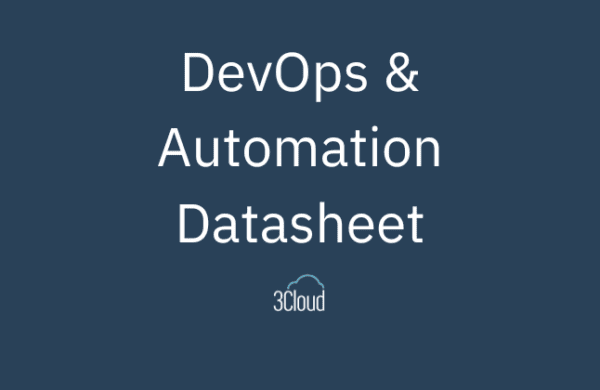As you come into work on a Monday, you find your team is about to start down a path whereby they are going to commit to significant architectural refactoring of the application. You talk to the senior developer and ask “why?” The answer you hear back is unsatisfying as it is obscure. Phrases such as “separations of concerns” and “single responsibility principal” are mentioned faster than you can actually drink your first cup of coffee. Scenarios like this happen every day. How do you validate that this is the right thing to do or not?
We founded 3Cloud because we were (and still are very) passionate about making the IT landscape a better place. We help our customers by providing advice, implementation, and knowledge transfer on the principals that help an IT team/organization be successful. As part of that process, we like to listen to our customers and truly understand how they are getting their work done before we set out to help any change. For us, we call that the “Assessment.”
An ALM Assessment is meant to (1) understand the current situation (2) identify any really good practices that can be built upon (3) find out any areas of investment that may result in increased maturity/success for that team(s). As part of the results, which do vary based upon immediate and longer-term needs – a roadmap can be created which consist of modifications to process, tools, and practices/people which should improve things. Most carefully, managers should take those assessments and apply an ROI paradigm to them. Questions like “Which of the following improvements should have a real positive ROI?” or “Which ones have the highest?” come to mind, and they should.
As an example, if it’s recommended that the team should adopt automated build or deployments, how much will this improve my team? As a suggestion, I’d recommend consider what the ROI on automated deployment might actually be. To get there, you can take a high level view on what the ROI should be – and then just like good computer scientists, divide-and-conquer that problem.
- ROI = (Gain from Investment – Cost of Investment) / Cost of Investment
Implementing automated build and deployment can be estimated and priced. The gain from doing so is more difficult because it represents the removal of the cost of doing it the “old way.”
- Gain = Cost of Manually Building Today + Cost of Outages from Manual Process
- Gain = Cost of Single Manual Build * Frequency + Cost of Outages
- Gain = Hourly Salary * Duration of Single Manual Build * Frequency + Lost Revenue * Probability of Outages
An example of ROI over simplified – for a single year.
- ROI = (40K – 10K) / 10K = 3.0
If we spend 10K to remove 40K of costs to our company. This is a win. Should we do this first?
Maybe – it depends where this stacks up against other initiatives within the IT organization. Perhaps better requirement analysis or superior unit testing might have significant gains to the organization. One major point here is – it is very hard to feel like this is an exact science because some of the practices mentioned within this article are tough to quantify benefits. When doing an exercise such as this, keep in mind that no matter what – this is an estimate and not actual. So the first challenge is figuring out what your variables are, and then putting in assumptions in for them.
This exercise, I believe, is an important one. Unfortunately, few think about this in real practical terms. Phrases that truly are poor substitutes for this are that we all hear: “It’s faster” “It’s newer” “It’s more integrated.” They are good positioning statements, but ROI in your organization should start with these, not end with these.




